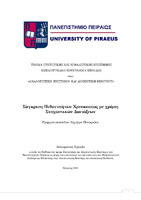Σύγκριση πιθανοτήτων χρεοκοπίας με χρήση στοχαστικών διατάξεων

View/
Keywords
Πιθανότητα χρεοκοπίας ; Στοχαστικές διατάξειςAbstract
The purpose of this dissertation is to connect the Ruin Theory with some basic Stochastic Processes. Initially the thesis presents the Collective Model and its characteristics as well as a number of Stochastic Processes with their properties. This analysis aims to draw specific conclusions regarding Ruin Theory. For instance, knowing in advance the losses distributions of two Individual portfolios, we could extract comparative conclusions about the Ruin Theory of those two portfolios. In the first chapter, a literature review concerning the concept of Actuarial Science and how it is used and applied to insurance companies is presented. Also, the Collective Model as well as the usefulness of the Stochastic Processes is described. In the second chapter, the Collective Model in Ruin Theory is presented as well as various important concepts around it such as height and amount of the individual claims, the total claims, their distribution and the probability generating function of the distribution, as well as the Poisson complex distribution. In addition, an introduction to Ruin Theory is given and useful concepts and quantities such as surplus growth, the possibility of bankruptcy in indefinite time, bankruptcy with the first compensation, the time of bankruptcy, the stepped heights and finally the maximum cumulative loss are presented. In the third chapter, an introduction regarding the definition of partial processes is given and then a number of Stochastic Processes (First Stochastic Dominance, Stop Loss, Convex Order, Harmonic Mean Residual Life Order) are presented, along with their basic properties. Finally, in the fourth chapter there are five examples that aim to assess through comparisons the ruin probability. These examples use the exponential distribution and the combination of exponential distributions for the heights of individual requirements of each portfolio, as well as the properties of the stochastic Processes that apply to each example. The calculation of all the necessary quantities is performed in order to reach the ruin probability of each portfolio. Each example is accompanied by various graphs which depict the quantities calculated for better understanding. For the purposes of the dissertation, the package Mathematica has been selected and utilized.


